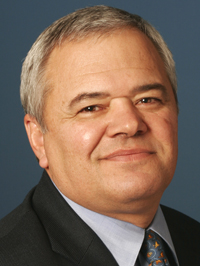Toll Bridge Stocks: Don’t Just Do Something, Sit There
by William Smead, Smead Capital Management
The floating bridge, which crosses from Seattle on one side of Lake Washington to Bellevue on the other, has been rebuilt and is almost completed. To finance the new bridge, a toll has been placed on its use. The other bridge, the I-90 bridge, requires no toll but takes you much farther out of your way. It is also jammed by cars wishing to avoid the toll. As a result, the floating bridge is a much more attractive option when traveling to Bellevue because there is less worry about losing time to traffic jams.
A wonderful business to own in the stock market is one which functions similarly to a toll bridge. It is a business with many customers who need to cross over the path and are willing to pay a premium to do so. The neat thing about owning toll-bridge companies is that their success is not built on momentum or pyramiding. Therefore, very few investment decisions need to be made and the portfolio sees very low turnover. In other words, you can, for the most part, just sit there and not have to do much of anything to accumulate wealth over the years.
Three years ago, a study was done on trading costs and their effect on U.S. equity mutual fund performance. In our large-cap value domain, turnover and its costs were using well over .80% or 80 basis points of annual return. Turnover across all large equity portfolios averaged 62%. Your common stock portfolio is like a bar of soap. The more you rub it, the smaller it gets. Just sitting there has significant benefits. In fact, we believe it is the main advantage the S&P 500 Index has over most active equity managers.
In his books like The Millionaire Next Door, Dr. Thomas Stanley taught us that keeping annual expenses low was as important to building wealth as creating high income. By averages, folks in the U.S. who built high net worth had lived in the same house for 25 years, had driven the same cars a long time and had stayed married to the same person. In other words, in their day-to-day life, they practiced low turnover.
At Smead Capital Management, we prefer to find wonderful, addicted-customer businesses that run like a toll bridge and do not require a genius to operate the business. Toll bridge companies have a series of people who must cross their path and have immense pricing flexibility, simply because the customer has little or no other choice. Our goal is to create wealth slowly and toll-bridge companies have historically done a good job of doing so for shareholders.
A good example of this is banking. It is lucrative because you get to make money on other peoples’ money with about 9-to-1 leverage, and the business is really not that complex. You need deposits and to find lending customers who will pay you back. Market share for our big three bank holdings have grown since the financial meltdown. With massive technology needs and a large regulatory burden placed on all banks by the Dodd-Frank legislation, the big banks have been the best positioned to spread legal, regulatory and technology costs over a larger and larger deposit base. The fact that they are everywhere enhances their toll bridge nature.
You need economic activity to create velocity in money. Velocity means reusing the same money over and over again. Banks make more when there is demand for credit and higher economic activity gives them a chance to serve more customers. We believe 86 million Millennials will begin to cross the banking toll bridge and will give us all the car and home buying the next ten years that our banks can handle. They should cause higher interest rates―a bonanza historically for our bank stocks. Jaime Dimon (chairman, president and CEO of JPMorgan Chase), John Stumpf (chairman and CEO of Wells Fargo) and Brian Moynihan (chairman and CEO of Bank of America) are really good managers, but someone will succeed them someday. The toll-bridge nature of these banks, the moat around the businesses and their simplicity will carry on for decades.
Tegna is another good example of a toll-bridge business. The company owns and operates 46 network-affiliated TV stations. They produce local news programming, like public safety, community affairs, politics, sports and weather. They are the largest owner of CBS and NBC affiliates other than CBS and NBC, and their main competition is the three other local broadcaster affiliates. No other web-based organization gathers the news like they do and are invested in the local community like they are. News is always there and the price to obtain it doesn’t fluctuate much! In our opinion, Tegna should feast on local auto dealer advertising, who want to reach the Millennials as they buy bigger vehicles to fit bigger families as they form households the next ten years. The CEO of Tegna, Gracia Martore, is a very good manager of the business, but Tegna’s toll-bridge nature and simplicity would lay the groundwork for someone to come along behind her to run the business when she retires.
Tegna and other toll-bridge companies only need the population in their main markets to grow in the future. If Phoenix is any example (where they own the NBC affiliate) things should be pretty good for Tegna. The Phoenix Metro area is expected to grow to 6 million people by 2030 (up from 4.5 million today) and become the nation’s fourth largest city in the process. Sounds easier than perpetuating momentum in one of today’s exciting technology businesses and certainly allows us to “just sit there” for a long time.
We, as an organization, are always wary of companies who are accelerating stock market success through unsustainable momentum, which requires a regular changing of the guard. On the other hand, we love inexpensive toll bridges which have created wealth for patient investors over long stretches of time.
Sincerely,
William Smead
The information contained in this missive represents SCM’s opinions, and should not be construed as personalized or individualized investment advice. Past performance is no guarantee of future results. Bill Smead, CIO and CEO, wrote this article. It should not be assumed that investing in any securities mentioned above will or will not be profitable. A list of all recommendations made by Smead Capital Management within the past twelve month period is available upon request.
This Missive and others are available at www.smeadcap.com.
Copyright © Smead Capital Management














